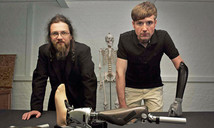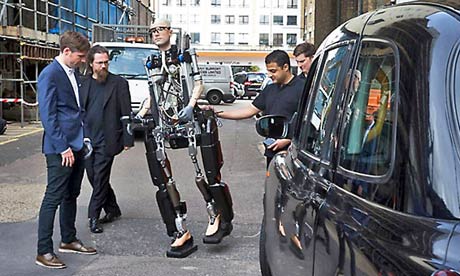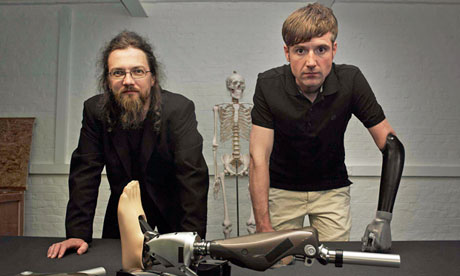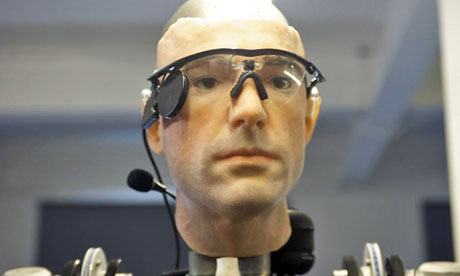/ News

How to build a bionic man
Rex the bionic man shows how close technology is to catching up with – and exceeding – the abilities of the human body.

He cuts a dashing figure, this gentleman: nearly seven feet tall, and possessed of a pair of striking brown eyes. With a fondness for Ralph Lauren, middle-class rap and sharing a drink with friends, Rex is, in many ways, an unexceptional chap.
Except that he is, in fact, a real-world bionic man. Housed within a frame of state-of-the-art prosthetic limbs is a functional heart-lung system, complete with artificial blood pumping through a network of pulsating modified-polymer arteries. He has a bionic spleen to clean the blood, and an artificial pancreas to keep his blood sugar on the level. Behind the deep brown irises are a pair of retinal implants, giving him a vista of the crowds of curious humans who meet his gaze.
He even has a degree of artificial intelligence: talk to him, and he'll listen (through his cochlear implants), before using a speech generator to respond. Although, like us, he sometimes stumbles over his words, memorably describing his idol Eminem as a "well-known crapper", before quickly correcting himself.
Created by Darlow Smithson Productions (DSP, the TV company behind Touching The Void and Richard Hammond's Engineering Connections), with the help of robotics experts Shadow Robot Company, the bionic man was conceived as a literal response to the question: how close is bionic technology is to catching up with – and even exceeding – the capabilities of the human body?
DSP got in touch with Dr Bertolt Meyer, a charismatic young researcher from Zurich University and himself a lifelong user of prosthetic technology, and invited him to, essentially, rebuild himself in bionic form. The result can be seen in How to Build a Bionic Man, to be broadcast on Channel 4 on 7 February. The Bionic Man himself will then reside in the Science Museum's Who Am I? gallery from 7 February until 11 March.

Richard Walker (left), chief roboticist, and Dr Bertolt Meyer (right) at the Body Lab. On the table is an iWalk BiOM ankle. Photograph: Channel 4
Build yourself in bionic form … it's not the sort of invitation a chap gets every day. What made Bertolt agree to it? "My aim was to show that prostheses can, instead of conveying a sense of loss, pity, and awkwardness, convey a sense of 'wow' and amazement - a positive reaction, if you will," he tells me.
The engineering behind modern prosthetics is certainly awe-inspiring. The iLimb Ultra, of which Bertolt is a user, is part of the new class of myoelectric prosthetics. These custom-made devices function by placing electrical sensors directly in contact with the skin. These sensors pick up the signals generated by muscular movements in the residual limb - signals that are then translated by software into natural, intuitive movement in the prosthetic limb.
We all know about prosthetic limbs, even if many of us are not aware of just how sophisticated they now are. Less familiar, though, is the idea of bionic organs. Far removed from the iron lung of yore, these new fully integrated artificial body parts are designed to plug directly into our own metabolism - in effect, they are not within us, they become us. They're the ultimate in biomimicry.
Take the elegant simplicity of Bionic Man's pancreas, invented by Prof Joan Taylor of De Montfort University. Within a protective casing of firm gel lies a store of insulin. In the presence of excess glucose, the gel begins to soften and liquefy, releasing the insulin – and as glucose levels drop in response to the insulin release, then gel hardens once again, in a self-regulating loop. Like a natural pancreas, this device requires no conscious monitoring – implanted permanently within the body, it plugs directly into our own homeostatic systems, potentially liberating us from the chore of blood sugar monitoring. It is, Prof. Taylor hopes, only around seven years from general use.
Bionic Man's kidney is, likewise, an implantable, self-regulating artificial organ. The brainchild of Prof Shuvo Roy's team at the University of California, San Francisco, it's made up of a silicon nanoscale filtration system, which requires only the power of the body's own blood pressure. The filtrate thus generated is then passed to a miniature bioreactor - a small cartridge housing living renal tubule cells from a healthy donor. Together, these components will - it is hoped - perform all the functions of a biological kidney. Clinical trials are due to begin in 2017.

Rex has some artificial intelligence: talk to him and he'll listen (through his cochlear implants), before using a speech generator to respond. Photograph: Channel 4
It's one thing to use a bionic organ to replace lost function. But in a future world where we could, feasibly, replace virtually all of our body, will we blur the boundaries of artificial and natural to an extent that we have to recalibrate our definition of self and non-self? That's especially pertinent when we consider the reality of neural prosthetics, like the "memory chips" developed by Dr Theodore Berger. Instinctively, many of us are uncomfortable with brain implants - but should we be? And will this discomfort be reduced if we broaden our definition of self?
Bertolt himself is pleased with the increasing normalisation, and even "coolness", of prosthetics. But he expresses caution about the potential for elective use of such technology - would we ever choose to remove a healthy body part, in order to replace it with a stronger, better prosthetic? Elective use of artificial body parts would, Bertolt fears, result in market forces becoming more important than medical need. In essence, those who can afford it could build "super bodies" - with the risk that prosthetic and bionics manufacturers would then focus on fulfilling those demands, rather than on the less profitable medical needs of the rest of us.
What's already certain, though, is that artificial body parts can already restore independence to us in a way never previously possible. Bionic Man is a visceral, visual way to show just much of our bodies could be replaceable in the near future. As a piece of engineering outreach, he is unique - and as a symbol of future humanity, he is startling.
How To Build A Bionic Man will be broadcast on Channel 4 on 7 February. The bionic man can be seen in a new free display in the Who Am I? gallery at London's Science Museum from 7 February until 11 March
Source: http://www.guardian.co.uk/science/blog/2013/jan/30/build-bionic-man
/ About us
Founded by Russian entrepreneur Dmitry Itskov in February 2011 with the participation of leading Russian specialists in the field of neural interfaces, robotics, artificial organs and systems.
The main goals of the 2045 Initiative: the creation and realization of a new strategy for the development of humanity which meets global civilization challenges; the creation of optimale conditions promoting the spiritual enlightenment of humanity; and the realization of a new futuristic reality based on 5 principles: high spirituality, high culture, high ethics, high science and high technologies.
The main science mega-project of the 2045 Initiative aims to create technologies enabling the transfer of a individual’s personality to a more advanced non-biological carrier, and extending life, including to the point of immortality. We devote particular attention to enabling the fullest possible dialogue between the world’s major spiritual traditions, science and society.
A large-scale transformation of humanity, comparable to some of the major spiritual and sci-tech revolutions in history, will require a new strategy. We believe this to be necessary to overcome existing crises, which threaten our planetary habitat and the continued existence of humanity as a species. With the 2045 Initiative, we hope to realize a new strategy for humanity's development, and in so doing, create a more productive, fulfilling, and satisfying future.
The "2045" team is working towards creating an international research center where leading scientists will be engaged in research and development in the fields of anthropomorphic robotics, living systems modeling and brain and consciousness modeling with the goal of transferring one’s individual consciousness to an artificial carrier and achieving cybernetic immortality.
An annual congress "The Global Future 2045" is organized by the Initiative to give platform for discussing mankind's evolutionary strategy based on technologies of cybernetic immortality as well as the possible impact of such technologies on global society, politics and economies of the future.
Future prospects of "2045" Initiative for society
2015-2020
The emergence and widespread use of affordable android "avatars" controlled by a "brain-computer" interface. Coupled with related technologies “avatars’ will give people a number of new features: ability to work in dangerous environments, perform rescue operations, travel in extreme situations etc.
Avatar components will be used in medicine for the rehabilitation of fully or partially disabled patients giving them prosthetic limbs or recover lost senses.
2020-2025
Creation of an autonomous life-support system for the human brain linked to a robot, ‘avatar’, will save people whose body is completely worn out or irreversibly damaged. Any patient with an intact brain will be able to return to a fully functioning bodily life. Such technologies will greatly enlarge the possibility of hybrid bio-electronic devices, thus creating a new IT revolution and will make all kinds of superimpositions of electronic and biological systems possible.
2030-2035
Creation of a computer model of the brain and human consciousness with the subsequent development of means to transfer individual consciousness onto an artificial carrier. This development will profoundly change the world, it will not only give everyone the possibility of cybernetic immortality but will also create a friendly artificial intelligence, expand human capabilities and provide opportunities for ordinary people to restore or modify their own brain multiple times. The final result at this stage can be a real revolution in the understanding of human nature that will completely change the human and technical prospects for humanity.
2045
This is the time when substance-independent minds will receive new bodies with capacities far exceeding those of ordinary humans. A new era for humanity will arrive! Changes will occur in all spheres of human activity – energy generation, transportation, politics, medicine, psychology, sciences, and so on.
Today it is hard to imagine a future when bodies consisting of nanorobots will become affordable and capable of taking any form. It is also hard to imagine body holograms featuring controlled matter. One thing is clear however: humanity, for the first time in its history, will make a fully managed evolutionary transition and eventually become a new species. Moreover, prerequisites for a large-scale expansion into outer space will be created as well.
Key elements of the project in the future
• International social movement
• social network immortal.me
• charitable foundation "Global Future 2045" (Foundation 2045)
• scientific research centre "Immortality"
• business incubator
• University of "Immortality"
• annual award for contribution to the realization of the project of "Immortality”.



 LinkedIn
LinkedIn
 LiveJournal
LiveJournal
 Google
Google
 Twitter
Twitter
 Facebook
Facebook
 Я.ру
Я.ру
 ВКонтакте
ВКонтакте
 Mail.ru
Mail.ru